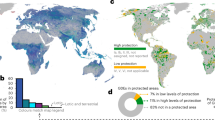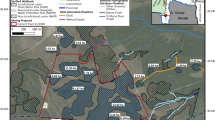Abstract
Geyser basins provide high value recreation, scientific, economic and national heritage benefits. Geysers are globally rare, in part, because development activities have quenched about 260 of the natural endowment. Today, more than half of the world’s remaining geysers are located in Yellowstone National Park, northwest Wyoming, USA. However, the hydrothermal reservoirs that supply Yellowstone’s geysers extend well beyond the Park borders, and onto two “Known Geothermal Resource Areas”—Island Park to the west and Corwin Springs on the north. Geysers are sensitive geologic features that are easily quenched by nearby geothermal wells. Therefore, the potential for geothermal energy development adjacent to Yellowstone poses a threat to the sustainability of about 500 geysers and 10,000 hydrothermal features. The purpose here is to propose that Yellowstone be protected by a “Geyser Protection Area” (GPA) extending in a 120-km radius from Old Faithful Geyser. The GPA concept would prohibit geothermal and large-scale groundwater wells, and thereby protect the water and heat supply of the hydrothermal reservoirs that support Yellowstone’s geyser basins and important hot springs. Proactive federal leadership, including buyouts of private groundwater development rights, can assist in navigating the GPA through the greater Yellowstone area’s “wicked” public policy environment. Moreover, the potential impacts on geyser basins from intrusive research sampling techniques are considered in order to facilitate the updating of national park research regulations to a precautionary standard. The GPA model can provide the basis for protecting the world’s few remaining geyser basins.




Similar content being viewed by others
References
Aguilar A (1996) Extremophile research in the European Union: from fundamental aspects to industrial expectations. Federation of European Microbiological Societies Microbiology Reviews 18:89–92
Barrick KA (2007) Geyser decline and extinction in New Zealand—energy development impacts and implications for environmental management. Environmental Management 39:783–805
Brock TD (1997) The value of basic research: discovery of Thermus aquaticus and other extreme thermophiles. Genetics 146:1207–1210
Bromley C (2003) Practical methods of minimizing or mitigating environmental effects from integrated geothermal developments; recent examples from New Zealand. International Geothermal Conference, Reykjavik, September 2003, Session #12, pp 26–32
Davenport MA, Borrie WT (2005) The appropriateness of snowmobiling in national parks: an investigation of the meanings of snowmobiling experiences in Yellowstone National Park. Environmental Management 35(2):151–160
Dodd EM (1988) The Geothermal Steam Act: unlocking its protective provisions. In: Simon DJ (ed) Our common lands—defending the National Parks. Island Press, Washington, DC, pp 425–446
Donaldson IG (1980) Geothermal energy resources can also be tourist resources: lessons from Wairakei and Rotorua-Whakarewarewa, New Zealand. In: Ramey HJ, Kruger P (eds) Proceedings of the sixth workshop geothermal reservoir engineering. Stanford geothermal program, workshop report SGP-TR-50, pp 41–48
Dustin DL, Schneider IE (2004) The science of politics/the politics of science: examining the snowmobile controversy in Yellowstone National Park. Environmental Management 34(6):761–767
Egan T (1992) Feud over geothermal water rights pits Yellowstone against a Church. New York Times, 17 July 1992, New York Times.com
Fenner CN (1936) Bore-hole investigations in the Yellowstone Park. Journal of Geology 44:225–315
Freemuth J, Cawley RM (1998) Science, expertise and the public: the politics of ecosystem management in the greater Yellowstone ecosystem. Landscape and Urban Planning 40:211–219
Freeston DH (1991) Small geothermal power plant developments. In: Freeston DH, Browne PRL, Scott GL (eds) Proceedings of the 13th New Zealand geothermal workshop. Geothermal Institute, University of Auckland, Auckland, New Zealand, pp 285–296
Friedman I (1997) Yellowstone seen through water and glass—a geologist shares his recollections of discovery and his concern for the future of Yellowstone’s geysers. Yellowstone Science 5(4):9–14
Georgsson LS, Saemundsson K, Hjartarson H (2005) Exploration and development of the Hveravellir Geothermal Field, N-Iceland. Proceedings of the world geothermal congress, Antalya, Turkey, pp 24–29
Goyer GG, Watson RD (1964) Report in appendix IV of final report fourth Yellowstone field research expedition. Publication no. 22, Atmospheric Sciences Research Center, State University of New York, Albany, 124 pp
Goyer GG, Grant LO, Henderson TJ (1966) The laboratory and field evaluation of weathercord, a high output cloud seeding device. Journal of Applied Meteorology 5:211–216
Hutchinson RA, Westphal JA, Kieffer SW (1997) In situ observations of Old Faithful Geyser. Geology 25:875–878
Koenig LR (1965) Drop freezing through drop breakup. Journal of the Atmospheric Sciences 22:448–451
Lindstrom B (1996) Biodiversity, ecology, and evolution of hot water organisms in Yellowstone National Park: symposium and issues overview. Park Science 16(1):12–13
Loomis B (1992) Crews plug source of leaking geyser in park. Jackson Hole Guide, November 25, Jackson, Wyoming
Lynch HJ, Hodge S, Albert C, Dunham M (2008) The greater Yellowstone ecosystem: challenges for regional ecosystem management. Environmental Management 41:820–833
McBeth MK, Shanahan EA (2004) Public opinion for sale: the role of policy marketers in greater Yellowstone policy conflict. Policy Sciences 37:319–338
McBeth MK, Shanahan EA, Jones MD (2005) The science of storytelling: measuring policy beliefs in greater Yellowstone. Society and Natural Resources 18:413–429
McBeth MK, Shanahan EA, Arnell RJ, Hathaway PL (2007) The intersection of narrative policy analysis and policy change theory. The Policy Studies Journal 35(1):87–108
Mcmillion S (1999) Selling off the promised land. High Country News, Paonia, Colorado. www.hcn.org
Morris JM, McBeth MK (2003) The new west in the context of extractive commodity theory: the case of bison-brucellosis in Yellowstone National Park. The Social Science Journal 40(2):233–247
Nash R (1982) Wilderness and the American mind. Yale University Press, New Haven, 425 pp
Nie M (2003) Drivers of natural resource-based political conflict. Policy Sciences 36:307–341
Nie M (2008) The Governance of Western lands: mapping its present and future. University Press of Kansas, Lawrence, KS, 376 pp
Peters J, Bothner B, Kelly S (2007) Unfolding the mystery of protein thermostability. Yellowstone Science 15:5–14
Rothschild LJ, Mancinelli RL (2001) Life in extreme environments. Nature 409:1092–1101
Sabatier PA, Jenkins-Smith HC (1999) The advocacy coalition framework: an assessment. In: Sabatier PA (ed) Theories of the policy process. Westview Press, Boulder, CO, pp 117–166
Schullery P (1999) Searching for Yellowstone: ecology and wonder in the last wilderness. Mariner Books, Boston, 352 pp
Shanahan EA, McBeth MK, Hathaway PL, Arnell RJ (2008) Conduit or contributor? The role of media in policy change theory. Policy Science 41:115–138
Sorey ML (2000) Geothermal development and changes in surficial features: examples from the western United States. Proceedings of the world geothermal congress 2000, Kyushu-Tohoku, Japan, May 28–June 10, 2000, pp 705–711
Sorey ML, Colvard EM (1992) Factors affecting the decline in hot-spring activity in the Steamboat Springs area of critical environmental concern, Washoe County, Nevada. US Geological Survey Administrative Report for the Bureau of Land Management, 109 pp
Sorey ML, Colvard EM (1997) Hydrologic investigations in the Mammoth corridor, Yellowstone National Park and vicinity, U.S.A. Geothermics 26(2):221–249
Tester JW, Anderson BJ, Batchelor AS, Blackwell DD, DiPippo R, Drake EM, Garnish J, Livesay B, Moore MC, Nichols K, Petty S, Toksöz MN, Veatch RW Jr (2006) The future of geothermal energy—impact of enhanced geothermal systems (EGS) on the United States in the 21st century. Massachusetts Institute of Technology and US Department of Energy, 332 pp
Tierney J, Frasure W (1998) Culture wars on the frontier: interests, values, and policy narratives in public lands politics. In: Cigler AJ, Loomis BA (eds) Interest group politics. Congressional Quarterly Press, Washington, DC, pp 303–325
USFS (US Forest Service) (1980) Final environmental impact statement of the Island Park Geothermal Area. United States Forest Service, Intermountain Region, Ogden, UT, 280 pp
van den Burg B (2003) Extremophiles as a source for novel enzymes. Current Opinion in Microbiology 6:213–218
White DE, Fournier RO, Muffler LJP, Truesdell AH (1975) Physical results of research drilling in thermal areas of Yellowstone National Park, Wyoming. US Geological Survey Professional Paper 892, Government Printing Office, Washington, DC, 70 pp
Wilson MA (1997) The wolf in Yellowstone: science, symbol, or politics? Deconstructing the conflict between environmentalism and wise use. Society and Natural Resources 10(5):453–468
Acknowledgments
I would like to thank the anonymous reviewers and the editor for helpful suggestions that greatly improved the manuscript. The research was not supported or funded by any interest group or government agency.
Author information
Authors and Affiliations
Corresponding author
Rights and permissions
About this article
Cite this article
Barrick, K.A. Protecting the Geyser Basins of Yellowstone National Park: Toward a New National Policy for a Vulnerable Environmental Resource. Environmental Management 45, 192–202 (2010). https://doi.org/10.1007/s00267-009-9390-9
Received:
Accepted:
Published:
Issue Date:
DOI: https://doi.org/10.1007/s00267-009-9390-9




